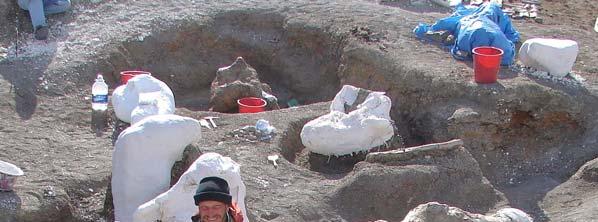
3 minute read
Dreadnoughtus
Dreadnoughtus—The Biggest Land Creature Ever!
By Chris Wilkinson
What is taller than the Cook Office Building and longer than an Olympic swimming pool? If you guessed “Dreadnoughtus, the largest land‐based animal ever discovered”, then congratula ons—you are as big of a dino‐nerd as I am. This massive dinosaur was so big that excava ng the monster took a period of four years. Archeologists were able to es mate from the skeleton that during its me of existence, the tan weighed in at 65 tons and measured 85 feet from nose to tail, making it far and beyond the largest land based organism to ever have roamed the earth and almost twice as large as the be er‐known Brachiosaurus. It is an incredible find for archaeologists (and dino‐enthusiasts such as myself), but it is not just because of the nature of the find.
Discovered in Argen na’s southwestern Patagonia, Dreadnoughtus is unique in its completeness—more than 70% of the mammoth’s skeleton was found intact, notably more than the typical 10% of its brethren. Due to the completeness of significant bones—including the humerus and femur—the scien sts were able to determine the animal’s mass and growth poten al. The key word in that sentence, which should be causing you to recoil in your seat slightly, would be “poten al,”—as in this 85 feet long, two story tall monster was not fully grown. It is difficult to tell what the maximum size of this skyscraper could have been, but odds are it would make Stephen Spielberg weep at the missed opportuni es.

The scien fic name, Dreadnoughtus schrani, has a first name that breaks down into “fear nothing”. This is likely, in my opinion, the most accurate binomial nomenclature known to science, as it’s hard to picture anything challenging a monstrosity that could have accidentally crushed you without no cing or par cularly caring. Although it may have been an herbivore in an ecosystem that resembles a more brutal Godzilla movie, you’re likely to be aggressive no ma er what your thoughts on ea ng your best friend are. Apatosauri, cousins to the new family of Titanosaurs that Dreadnoughtus belongs to, have been projected to have tails that released nearly 2,000 mes more energy than a bull whip when cracked, and could easily deafen nearby organisms with its 200 decibel boom. Assuming these were not merely for show, it’s likely that having larger tails was a necessary defense against the extremely well‐armed carnivores that viewed everything and anything as giant meat sacks.


Dreadnoughtus paints a picture of an increasingly astounding ecosystem that existed before we were even a concept. It’s thought‐provoking to think of the evolu onary circumstances that would favor such massive features, and really shows how different the environment was back then. It also shows how not at all welcome we would have been back then, and perhaps it’s for best that there’s a comfortable buffer of a couple dozen million years between us. Archaeologists have a special place in all of our hearts as the people who made Jurassic Park possible (and also being cu ng edge scien sts, but that’s probably a secondary honor), and their work adds to many fields of environmental study—ecology, animal physiology, evolu on, and just about everything that benefits from knowledge of biological history.


Sources:
http://www.jhunewsletter.com/2014/09/18/new-dinosaur-dreadnoughtus-found-in-argentina-43851/
http://www.cnn.com/2014/09/04/world/americas/dreadnoughtus-huge-dinosaur/
http://www.nytimes.com/2014/09/05/science/dinosaur-dreadnoughtus-discovery.html?_r=0










